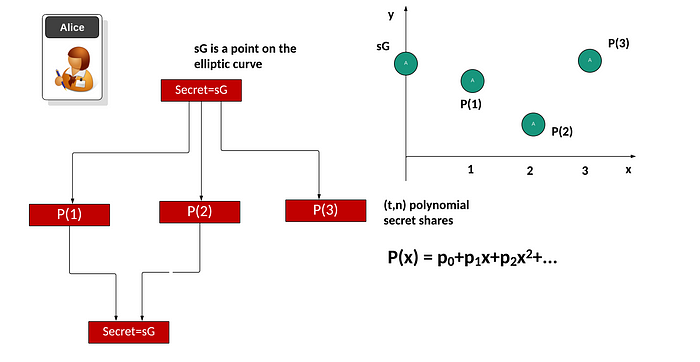冷密钥共享
- asecuritysite
- 发布于 2025-06-15 09:30
- 阅读 1404
本文介绍了FROST(Flexible Round-Optimised Schnorr Threshold)方法,它是一种将密钥分割成多个碎片并在达到阈值数量后恢复密钥的技术。FROST通过分布式签名实现阈值签名,其中n个参与者中的任何t个都可以生成有效的签名,同时探讨了其在加密货币交易、身份验证和密钥恢复等领域的应用。

Frosty Key Shares
在 LastingAsset,我们的目标是支持隐私感知的方法来存储个人详细信息,例如私钥、位置详细信息和受信任的电话号码。为此,我们可以将一个密钥拆分成多个密钥分片(secret shares),然后将它们存储在受信任的位置。这样,私钥就不会存在于任何单一位置,而只能从这些受信任的位置恢复。为此,我们可以采用全有或全无 (AoN) 的方法,在这种方法中,我们必须恢复密钥的所有分片才能重建它。但是,为了提高弹性,我们可以使用 Shamir 秘密共享 (SSS) 方法来支持任何 t-and-n 的共享方法。例如,我们可以将密钥分成五个片段,然后只需要组合三个片段即可恢复密钥。在本例中,我们将使用 FROST (Flexible Round-Optimised Schnorr Threshold) 方法将密钥分成多个分片,然后使用给定阈值数量的分片来恢复它。
Shamir Shares
现在,我们经常使用椭圆曲线在密码学中执行高效的运算。有了这个,我们从一个秘密 (s) 开始,然后取曲线的基点(G),并生成一个 sG 的秘密。接下来,我们将 sG 转换为给定阈值 t 和 n 个分片的多个多项式因子。首先,我们将取分片点,然后将其拆分为多个多项式值,并且我们切割 y 轴的点将恢复分片。最初,我们将使用以下公式将多项式拟合到秘密:

其中 p 0, p 1 等等,是所需多项式的系数。然后我们将创建 P(1), P(2) 等等的分片。这些是当 x =1, x =2 等等时的点。然后可以将这些分片分发给将存储这些分片的实体。当需要时,我们收集至少 t 个分片以重新创建秘密( sG )。例如,我们可以使用 P(0), P(1) … P( t −1) 并使用曲线拟合方法来找到 P(0),它是多项式中 x =0 的点。然后将我们恢复的 P(0) 值转换回椭圆曲线点,以给出 sG :

FROST
FROST 分布式签名 [2, 3] 方法允许阈值签名,其中任何 t 个中的 n 个都可以生成有效的签名。有了这个,我们将密钥分发给 n 个参与者,其中需要 t 个参与者来重新生成密钥并生成有效的签名。每个参与者都持有密钥的一个分片。总的来说,它只需要两轮来计算签名,并使用基于 Schnorr 的阈值签名方法。在本例中,我们将使用多种密码套件,包括 Ristretto255Sha512、P256Sha2562、P384Sha384、P521Sha512、Edwards25519Sha512 和 Secp256k1Sha256。EdDSA 签名是确定性的,但 FROST 签名是非确定性的 (因此每次我们创建签名时都会更改)。zCash 目前正在将 FROST 方法集成到他们的钱包中。
在本例中,我们将使用任意 3-from-5 的分片,然后使用分片 1、3 和 5 来重新生成密钥分片,然后根据公钥对其进行测试 [ here]:
// Code based on https://github.com/bytemare/dkg/tree/main
package main
import (
"github.com/bytemare/ecc"
"github.com/bytemare/dkg"
"fmt"
"github.com/bytemare/secret-sharing/keys"
"slices"
secretsharing "github.com/bytemare/secret-sharing"
"os"
"strconv"
)
var testTable = []*testCase{
{
name: "Ristretto255 (3,5)",
ciphersuite: dkg.Ristretto255Sha512,
group: ecc.Ristretto255Sha512,
threshold: 3,
maxParticipants: 5,
},
{
name: "P-256 (3,5)",
ciphersuite: dkg.P256Sha256,
group: ecc.P256Sha256,
threshold: 3,
maxParticipants: 5,
},
{
name: "P-384 (3,5)",
ciphersuite: dkg.P384Sha384,
group: ecc.P384Sha384,
threshold: 3,
maxParticipants: 5,
},
{
name: "P-521 (3,5)",
ciphersuite: dkg.P521Sha512,
group: ecc.P521Sha512,
threshold: 3,
maxParticipants: 5,
},
{
name: "Edwards25519 (3,5)",
ciphersuite: dkg.Edwards25519Sha512,
group: ecc.Edwards25519Sha512,
threshold: 3,
maxParticipants: 5,
},
{
name: "SECp256k1 (3,5)",
ciphersuite: dkg.Secp256k1,
group: ecc.Secp256k1Sha256,
threshold: 3,
maxParticipants: 5,
},
}
type testCase struct {
name string
threshold uint16
maxParticipants uint16
ciphersuite dkg.Ciphersuite
group ecc.Group
}
func makeParticipants(c *testCase) []*dkg.Participant {
ps := make([]*dkg.Participant, 0, c.maxParticipants)
for i := range c.maxParticipants {
p, err := c.ciphersuite.NewParticipant(i+1, c.threshold, c.maxParticipants)
if err != nil {
}
ps = append(ps, p)
}
return ps
}
func runRound2(c *testCase, p []*dkg.Participant, r1 []*dkg.Round1Data) map[uint16][]*dkg.Round2Data {
r2 := make(map[uint16][]*dkg.Round2Data, c.maxParticipants)
for i := range c.maxParticipants {
r, err := p[i].Continue(r1)
if err != nil {
}
for id, data := range r {
if r2[id] == nil {
r2[id] = make([]*dkg.Round2Data, 0, c.maxParticipants-1)
}
r2[id] = append(r2[id], data)
}
}
return r2
}
func showDetails(c *testCase,pk *ecc.Element,pubKey *ecc.Element,secret *ecc.Scalar, shares []*keys.KeyShare) {
fmt.Printf("Participants: %d\n", c.maxParticipants)
fmt.Printf("Threshold: %d\n", c.threshold)
fmt.Printf("Name: %s\n", c.name)
if (c.ciphersuite==1) { fmt.Printf("Ciphersuite: Ristretto255Sha512\n") }
if (c.ciphersuite==3) { fmt.Printf("Ciphersuite: P256Sha2562\n") }
if (c.ciphersuite==4) { fmt.Printf("Ciphersuite: P384Sha384\n") }
if (c.ciphersuite==5) { fmt.Printf("Ciphersuite: P521Sha512\n") }
if (c.ciphersuite==6) { fmt.Printf("Ciphersuite: Edwards25519Sha512\n") }
if (c.ciphersuite==7) { fmt.Printf("Ciphersuite: Secp256k1Sha256\n") }
fmt.Printf("Group: %v\n", c.group)
fmt.Printf("\nRegenerated secret key %v\n", secret.Hex())
fmt.Printf("Public key (initial gen) %v\n", pubKey.Hex())
fmt.Printf("Public key (from shares) %v\n\n", pk.Hex())
fmt.Printf("\nShares used:\n") // 使用的分片
for _, k := range shares {
fmt.Printf("Share: %v\n", k.Hex()) // 分片
}
}
func main() {
testvector:=0
argCount := len(os.Args[1:])
if (argCount>0) {testvector,_ = strconv.Atoi(os.Args[1])}
c:= testTable[testvector]
p := makeParticipants(c)
r1 := make([]*dkg.Round1Data, c.maxParticipants)
// Step 1: Start and assemble packages.
for i := range c.maxParticipants {
r1[i] = p[i].Start()
}
// Step 2: Continue and assemble + triage packages.
r2 := runRound2(c, p, r1)
// Step 3: Clean the proofs.
// This must be called by each participant on their copy of the r1DataSet.
for _, d := range r1 {
d.ProofOfKnowledge.Clear()
}
// Step 4: Finalize
quals := []uint16{1, 3, 5}
keyShares := make([]*keys.KeyShare, 0, len(quals))
registry := keys.NewPublicKeyShareRegistry(c.group, c.threshold, c.maxParticipants)
pubKey, _ := dkg.VerificationKeyFromRound1(c.ciphersuite, r1)
for _, participant := range p {
keyShare, err := participant.Finalize(r1, r2[participant.Identifier])
if err != nil {
// t.Fatal(err)
}
if !keyShare.VerificationKey.Equal(pubKey) {
// t.Fatalf("expected same public key")
}
if !keyShare.PublicKey.Equal(c.group.Base().Multiply(keyShare.Secret)) {
// t.Fatal("expected equality")
}
if err := registry.Add(keyShare.Public()); err != nil {
// t.Fatal(err)
}
// Assemble a subset to test key recovery.
if slices.Contains(quals, participant.Identifier) { // only take the selected identifiers (1, 3 and 5)
keyShares = append(keyShares, keyShare)
}
}
{
commitments := dkg.VSSCommitmentsFromRegistry(registry)
for _, k := range keyShares {
if err := dkg.VerifyPublicKey(c.ciphersuite, k.Identifier(), k.PublicKey, commitments); err != nil {
// t.Fatal(err)
}
}
}
// Verify the threshold scheme by combining a subset of the shares.
{
combinedKeyShares := make([]*keys.KeyShare, 0, len(quals))
for _, k := range keyShares {
combinedKeyShares = append(combinedKeyShares, k)
}
secret, err := secretsharing.CombineShares(combinedKeyShares)
if err != nil {
// fmt.Printf("\nUnsuccessfully combined shares\n")
} else {
fmt.Printf("\nSuccessfully combined shares\n") // 成功合并分片
}
pk := c.group.Base().Multiply(secret)
if !pk.Equal(pubKey) {
// fmt.Printf("Recovered secret not compatible with public key\n")
} else {
fmt.Printf("Recovered secret is compatible with public key\n") // 恢复的密钥与公钥兼容
}
showDetails(c,pk,pubKey,secret,keyShares )
}
}一个示例运行 [ here]:
Successfully combined shares
Recovered secret is compatible with public key
Participants: 5
Threshold: 3
Name: Ristretto255 (3,5)
Ciphersuite: Ristretto255Sha512
Group: ristretto255_XMD:SHA-512_R255MAP_RO_
Regenerated secret key 82b27a7a6f19b941d168891d4e3d939aa1b4890b567f7038d66a23253a156c0a
Public key (initial gen) 7c2245a9059846a365506687380e63c21a46994e8ca41e0588b197b62b084f2f
Public key (from shares) 7c2245a9059846a365506687380e63c21a46994e8ca41e0588b197b62b084f2f
Shares used:
Share: 01010003000000ec00432795c49dd860fa5c85285ed1f3cd7ad4e756e64f7ed190ae73893d2d73587eb3ac3fdff241ffa7475c81455542f6868b2e3751e2eec9352decac85e45b6c29f9aad7603c1c28ddf80feeed52ec4e7c8427684f26e913ae64ffe830dc0b7a11d665735ccbad57c375f2a2b7ba45a969125ec96b8199cc38d20082b3b76366d2748e1c05ad62f43bc3b9b4a5c0d815e2c644752e90962a539c0a4c036e0e7c2245a9059846a365506687380e63c21a46994e8ca41e0588b197b62b084f2f
Share: 0103000300000008e6582d3e359e1c5efa2fe2a0fad7e71631c2e25ef4e5e8583f8e029f620f192694a21a756a9302842fe34fa3398ca9e1c51236e171aa514d32bf5d8d11b9660416b204f2c9ba07cef10205237c14ef766d6b7ed5b6c238558a904c03e1d8367e75a449caa3c0b4726dcdf50d96dba71ba609b1bb67672b9c72c0ab41128b66aec8bcefe05832d6f6a4f55bcb57c9dfb6e7cc1fbf8df99c298acfa2d66c68057c2245a9059846a365506687380e63c21a46994e8ca41e0588b197b62b084f2f
Share: 010500030000007637de1af3a7062ff6058cd2dcebbdf907f56b0c08a982ac19f4c5ffadc6862d92aee8a58297e2f6fb618d3617fe193ab0020f988b5ecfe0ea9ddf090de6ec6ccc70bf74e3fcf32b82a1e36c90f03c175adaf4ab52fe0d74940f072f62eafd2786c5a2e12fdaf85cfefd8b5919e379ec188e0938b728bd28d9f10769b5d8e05781130ee35ea2fd73596c18f0b6d682c2f8d037866dee9a5b46f459f7943d56007c2245a9059846a365506687380e63c21a46994e8ca41e0588b197b62b084f2f结论
虽然有几种多重签名方法,但 FROST 是一种创建分布式签名的高效方法。它在加密货币中的应用是显而易见的,我们可以创建一个签名者组,并且我们需要至少给定数量的签名者才能完成交易。但是,还有更多的应用,包括创建一组受信任的设备,这些设备能够验证一个人或在密钥/ID 恢复中发挥作用。
参考文献
[1] Shamir, A. (1979). How to share a secret. Communications of the ACM, 22(11), 612–613 [ here].
[2] Komlo, C., & Goldberg, I. (2020, October). FROST: Flexible round-optimized Schnorr threshold signatures. In International Conference on Selected Areas in Cryptography (pp. 34–65). Cham: Springer International Publishing.
[3] Connolly, D., Komlo, C., Goldberg, I., & Wood, C. A. (2024). The Flexible Round-Optimized Schnorr Threshold (FROST) Protocol for Two-Round Schnorr Signatures. RFC 9591. June 2024. doi: 10.17487/RFC9591. url: https://www. rfc-editor. org/info/rfc9591.
- 原文链接: medium.com/asecuritysite...
- 登链社区 AI 助手,为大家转译优秀英文文章,如有翻译不通的地方,还请包涵~
- 现代密码学 239 浏览
- 创建和验证零知识证明需要多长时间? 522 浏览
- ZK Mesh:2025年11月回顾 584 浏览
- ZK 编年史:数学基础 607 浏览
- Plinko PIR 教程 463 浏览
- How Babylon Vaults Unlock Trustless Bitcoin DeFi 485 浏览
- 更快的 Sumcheck:第一部分 245 浏览
- Vitalik Buterin 用 30 分钟介绍以太坊(2025 版) 881 浏览
- 深入探索范围:更深入地了解 Bulletproofs 212 浏览
- 深入探讨Bulletproofs:停留在范围内 199 浏览
- 单位根的 k/2 次幂等于 1 或 -1 453 浏览
- ZK编年史:初探 440 浏览

